Find out how fingerprint security technology works
Fingerprint scanning technology is not something new, it has been decades since the first fingerprint reader was born, and the technology has changed a lot.But fingerprint security has only really become explosive and is widely known when used on mobile devices such as smartphones and laptops.Fingerprint scanning technology today is no longer a "toy" exclusively for expensive flagship smartphones, but has even appeared on cheap products and gradually becomes a security technology. Additional hardware is indispensable.
Although daily contact with these types of devices, but certainly many of us still do not understand the principles of fingerprint scanning technology as well as the differences between different types of fingerprint scanning techniques.This article will help you better understand this advanced security technology.
Fingerprint security
- What is fingerprint scanning technology?
- How does fingerprint technology work?
- Optical fingerprint scanner
- Capacitive fingerprint scanner
- Ultrasonic fingerprint scanner
- Advantages and disadvantages of fingerprint security
- Advantages
- Defect
What is fingerprint scanning technology?
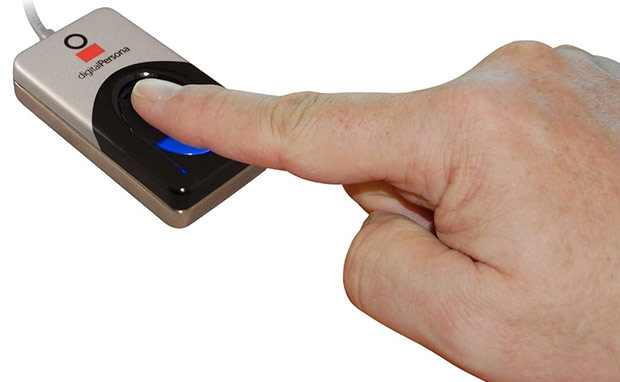
Fingerprint scanning is a security technology that uses one's fingerprint to identify that person's identity.As we all know each person will have their own fingerprint structures, or in other words our fingerprints are completely different.This is often called biometric fingerprint.Biometrics is a study of how people are different based on biological factors, such as how each person's fingerprints differ.Even identical twins do not share the same set of fingerprints.A person's fingerprint is like an identification card, and this is also the core foundation for creating fingerprint security technology.This technology is used not only in security systems, but also in the field of forensic science research and crime.It can even be found on home utilities, such as some of the laptops and smartphones we still use, or fingerprint scanning systems at work .
How does fingerprint technology work?
Based on the principle of operation, we can divide the fingerprint sensor into three main categories, and their working principle will be discussed here.
Optical fingerprint scanner
Optical fingerprint scanning method captures and compares oldest fingerprints up to the present time.As the name suggests, this technique is based on fingerprint optical imaging for identification.Basically, the device will use algorithms to process the images, analyze the lightest and darkest areas of the image, thereby detecting differences in the structure of the fingerprints and comparing them. with other data obtained.
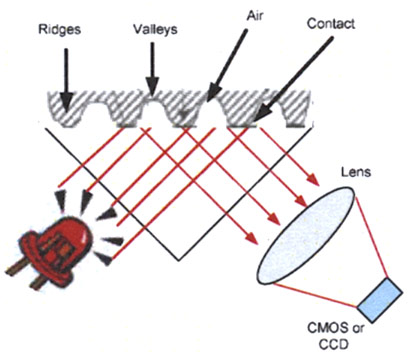
Just like a smartphone camera, these sensors can have a certain resolution and the higher the resolution, the better the image will be, through which the sensor can distinguish fingers. Your faster and more accurate, help improve security.However, these sensors will capture images that are much higher in contrast than conventional cameras, and fingerprint scanners will often have extremely high numbers of diodes per inch to capture these details at close range.Of course, the light from the outside environment will be obscured when your fingers are placed on the scanner, so the optical scanner is also integrated with LED ranges, used as a flash to provide light. for sensors.However, it can be seen that such a design is too cumbersome for a phone or laptop - devices that promote absolute mobility.So people have created amuch more compacttype of fingerprint scanner!
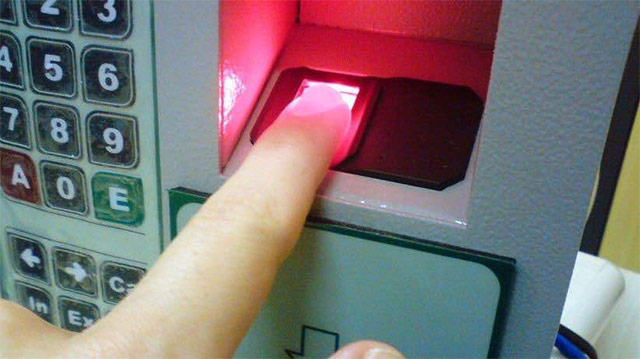
Capacitive fingerprint scanner
Capacitive fingerprint scanner is one of the most popular fingerprint reader technologies today.You will find these scanners in the flagship of different production lines, including Galaxy S9, HTC U12, LG G6 and other products.Once again, by name, we can also visualize the core components of this sensor, such as familiar electronic devices and capacitors.
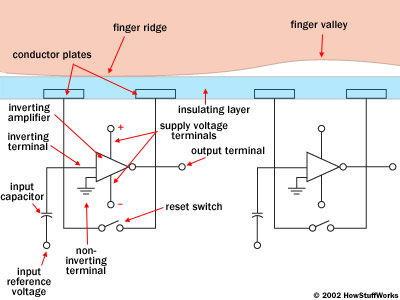
Instead of creating a copy of the image of the fingerprint template, the device uses small capacitor circuit boards to store the sample, fully remembering all fingerprint details.Because capacitors can store electrical charge, connecting them to conductive plates on the scanner's surface allows us to be able to use capacitors to keep track of fingerprint details.The electric charge stored in the capacitor will be changed slightly when the edge of the finger is placed on the conductive plate, while the air gap between the grooves on the fingerprint will help the charge at the capacitor close to as unchanged.An op-amp integrated circuit will be used to track these changes, which can then be recorded with an analog to digital converter.
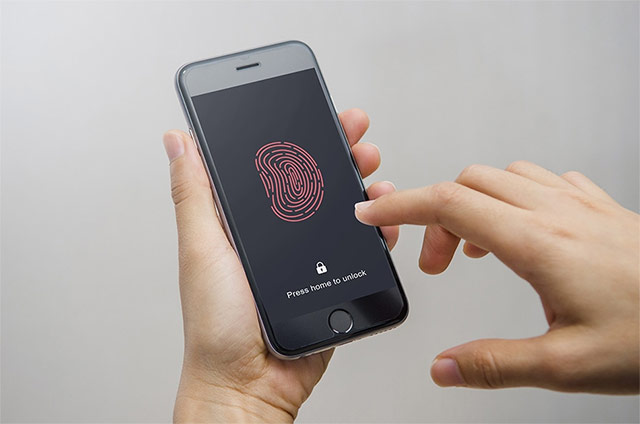
The advantage of this fingerprint scanning method lies in the processing speed and the ability to identify many of the fingerprint properties, thereby ensuring high security.The analysis of the lines and grooves on the fingerprint structure will become more detailed.In addition, due to complex structure, capacitive fingerprint scanner will cost more than the above optical type.The more capacitors, the higher the fingerprint recognition point will be, the more expensive the price will be, but the processing speed will be a bit slower because the sensor will have to scan more parameters.This requires manufacturers to simplify the device but still ensure security.
Ultrasonic fingerprint scanner
Ultrasonic fingerprint scanner is the latest and most modern technology in fingerprint identification on smartphones in particular and high-end electronic devices in general.Ultrasonic fingerprint scanner was first announced on the Le Max Pro smartphone, using Qualcomm's Sense ID technology.
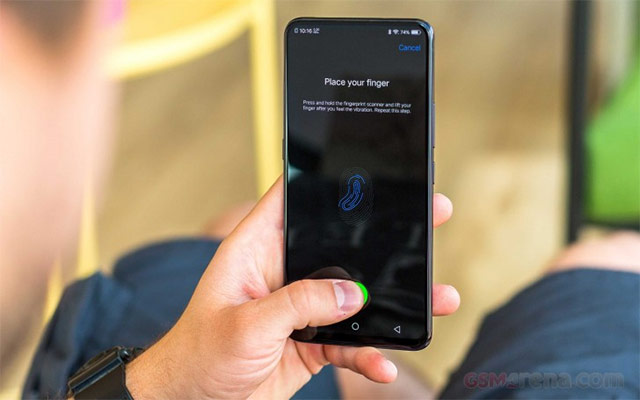
To really capture the details of a device fingerprint will use the transmitter and receiver for ultrasound.An ultrasound pulse is transmitted to the fingertip when it is placed on the scanner.By reflecting the reflected wave, the system can identify unique characteristics on each individual fingerprint.
Thanks to the smart sensor, the 3D version of the fingerprint structure will be faithfully reproduced with very detailed depth and depth.This is like an upgrade of capacitive sensors to increase device security.
Advantages and disadvantages of fingerprint security
While fingerprint scanners are built on the same hardware platform, they can make a difference, while creating outstanding features for users.However, fingerprint scanning does not always bring benefits.
Advantages
Some related advantages of fingerprint security technology are quite obvious.For example, thieves can steal passwords, PINs or locks, but they won't be able to fake your fingerprints.With fingerprint security, you won't have to worry about your fingerprint being detected as if it were a password, you won't have to worry about your fingerprints as you might forget your password.All of these factors not only help fingerprint security provide a high level of security, but also allow you to have more control over your devices and assets.Example: The software comes with most fingerprint scanning devices that allow you to give someone access to an area of a building as well as control the time they enter and exit the area.This feature also applies to many current workplaces, allowing timekeeping or time control to become much more efficient.
Defect
There are several disadvantages when using fingerprint scanning technology.The first is the cost, equipped with fingerprints on the technology equipment or for larger scales like businesses and organizations, of course will also entail certain costs incurred.However, technological advances are helping to reduce the cost of this type of security, such as the fact that you can see capacitive fingerprint security appearing on many cheap smartphones today.
Every other drawback of fingerprint security is the reliability and stability.Some low-quality devices will usually not recognize it if the user's finger sweats or becomes dirty.So if you want to use devices with fingerprint scanner integration, it is a good idea to choose a relatively small type, otherwise it's best not to use conventional security types alone.
Above are the basic information about fingerprint scanning technology and fingerprint security, hope you have gained the necessary knowledge about this kind of convenient security!
See more:
- Instructions on how to login to your computer when you forget your password
- Hack SIM: Things to know and how to avoid
- Learn about terminal security (endpoint security)
- The leading site to learn hacking skills
You should read it
- Can the phone be unlocked by the fingerprint of the dead?
- Things to know about USB fingerprint reader
- 8 unique ways to use fingerprint scanning on Android device
- Instructions for installing fingerprint sensor on LG G6 phone
- HP launched a pair of laptops that support fingerprint security
- There are vulnerabilities that allow hackers to bypass the fingerprint security mechanism of Lenovo computers
- HP launched a new mouse, providing a fingerprint security solution for the PC
- Fingerprint recognition will land on Windows Phone 8.1
- How does the in-display fingerprint sensor work?
- Video comparing opening fingerprint lock: 5S vs S5
- Should buy fingerprint timekeeper cheap, good quality?
- Where to buy fingerprint timekeeper to ensure genuine, cheap in Hanoi, TP. HCM?
May be interested

Top 5 trends in endpoint security for 2018

Learn about digital content management (DRM)

Kill viruses effectively with Malwarebytes Premium software

11 solutions to troubleshooting DNS Resolution

Instructions for unlocking Windows computers with fingerprints on Android phones

The best password management software today






 Can the phone be unlocked by the fingerprint of the dead?
Can the phone be unlocked by the fingerprint of the dead? Fingerprint recognition will land on Windows Phone 8.1
Fingerprint recognition will land on Windows Phone 8.1 HP launched a pair of laptops that support fingerprint security
HP launched a pair of laptops that support fingerprint security How is the world's largest bank secure?
How is the world's largest bank secure? There are vulnerabilities that allow hackers to bypass the fingerprint security mechanism of Lenovo computers
There are vulnerabilities that allow hackers to bypass the fingerprint security mechanism of Lenovo computers How to set up fingerprint for laptop win 10, absolute security
How to set up fingerprint for laptop win 10, absolute security